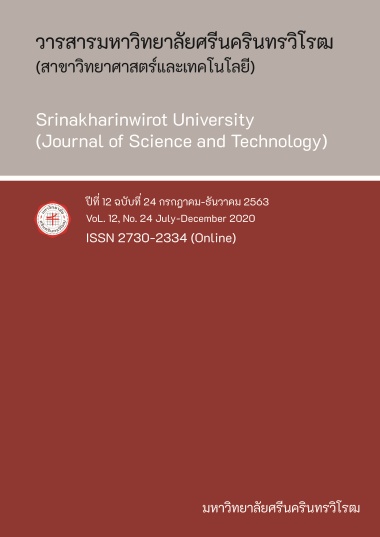ประสิทธิภาพการจัดการน้ำด้วยวิธีแบบเปียกสลับแห้งต่อการเจริญเติบโต และผลผลิตข้าว EFFICIENCY OF WATER MANAGEMENT BY ALTERNATIVE WETTING AND DRYING ON RICE GROWTH AND PRODUCTION
คำสำคัญ:
การทำนาแบบเปียกสลับแห้ง, การเจริญเติบโตและปริมาณผลผลิตข้าว, ข้าวพันธุ์ กข.41บทคัดย่อ
การจัดการน้ำแบบเปียกสลับแห้ง คือการจัดการน้ำในนาข้าวด้วยการควบคุมระดับน้ำในนาข้าวให้มีสภาพน้ำท่วมขังสลับกับการปล่อยให้แห้ง เพื่อกระตุ้นการเจริญเติบโตและปริมาณผลผลิตข้าว งานวิจัยมีวัตถุประสงค์เพื่อศึกษาประสิทธิภาพการใช้น้ำและการเจริญเติบโตของข้าวพันธุ์ กข 41 ทั้งส่วนเหนือพื้นดินและส่วนใต้ดิน ภายใต้การปลูกข้าวด้วยวิธีเปียกสลับแห้ง 2 เงื่อนไข คือ T3 ขังน้ำในนาข้าวที่ระดับ 10 ซม. และปล่อยให้น้ำลดลง 15 ซม. T2 ขังน้ำในนาข้าวที่ระดับ 5 ซม. และปล่อยให้น้ำลดลง 15 ซม. เปรียบเทียบกับการจัดการน้ำแบบปกติที่มีน้ำท่วมขังที่ระดับ 10 ซม. ตลอดฤดูกาลเพาะปลูก (T1) ณ แปลงวิจัยข้าวจังหวัดปราจีนบุรี จำนวน 2 ฤดูกาล ประกอบด้วยฤดูแล้ง (DS) และฤดูฝน (WS) ผลการศึกษาพบว่า การจัดการน้ำแบบเปียกสลับแห้งในเงื่อนไข T2 และ T3 ลดการใช้น้ำเฉลี่ยทุกฤดูกาลเพาะปลูกเมื่อเปรียบเทียบกับการจัดการน้ำแบบปกติ ร้อยละ 52 และ 32 ตามลำดับ การเจริญเติบโตและน้ำหนักของต้นข้าวในการจัดการน้ำเงื่อนไข T1 และ T2 แตกต่างกับ T3 อย่างมีนัยสำคัญทางสถิติ แต่อย่างไรก็ตาม ผลผลิตของข้าวทั้ง 3 เงื่อนไข ทุกฤดูกาลเพาะปลูก ไม่พบความแตกต่างอย่างมีนัยสำคัญทางสถิติ ในขณะที่การเจริญเติบโตของรากในฤดูฝนของ T2 และ T3 มีการเจริญเติบโตสูงกว่า T1 อย่างมีนัยสำคัญทางสถิติ (p-value < 0.05) ค่าเฉลี่ยการเจริญเติบโตของรากในเงื่อนไข T1, T2 และ T3 เท่ากับ 8,847, 11,217 และ 11,896 กิโลเมตร/เฮกตาร์ ตามลำดับ การทดลองนี้สรุปว่า การจัดการน้ำแบบเปียกสลับแห้งส่งผลต่อการเจริญเติบโตและการยืดขยายของรากข้าวแต่การย่อยสลายของรากข้าวทุกเงื่อนไขไม่แตกต่างกันทางสถิติ นอกจากนี้การเจริญเติบโตด้านความสูงของต้นข้าวและความยาวของรากใต้ดินมีความสัมพันธ์กันโดยรากมีการเจริญเติบโตเพิ่มขึ้นอย่างรวดเร็วจนถึงระยะข้าวมีการแตกกอ
Downloads
เอกสารอ้างอิง
[2] Office of Agricultural Economics. (2015). Compairison of greenhouse gas emission in paddy field between organic and traditional systems. Retrieved June 9, 2015, from http://www.oae.go.th
[3] Sharma, P.K. (1989). Effect of period moisture stress on water-use efficiency in wetland rice. Oryza, 26, 252-257.
[4] Yao, F., Huang, J., Cui, K., Nie, L., Xiang, J., Liu, X., Wu, W., Chen, M., Peng, S. (2012). Agronomic performance of high-yielding rice variety grown under alternate wetting and drying irrigation. Journal of Field Crops Research, 126, 16-22.
[5] Achara Chumvong. (2008). Water management in paddy field for reduction of environmental impacts on methane and water quality. Doctor of Engineering (Irrigation Engineering). Bangkok: Graduate school Kasetsart University.
[6] Redwanur, R., & Bulbul, S.H. (2014). Effect of alternate wetting and drying (AWD) irrigation for boro rice cultivation in Bangladesh. Agriculture, Forestry and Fisheries, 2, 86-92.
[7] Russell, R.S. (1977). Plant root system: their function and interaction with the soil. McGraw-Hill, London.
[8] Charoensilp, N., Buddhaboo, C., Promnart, P., Wassmann, R., & Lantin, R.S. (2000). Methane emission from deepwater rice fields in Thailand. Nutrient Cycling Agroecosystems, 58, 121-130.
[9] Chidthaisong, A., Cha-un, N., Rossopa, B., Buddaboon, C., Kunuthai, C., Sriphirom, P., Towprayoon, S., Takida, T., Padre, A.T., & Minamikawa, K. (2017). Evaluating the effects of alternate wetting and drying (AWD) on methane and nitrous oxide emission from a paddy field in Thailand. Soil Science and Plant Nutrition, 64, 1-8.
[10] Maeght, J.L., Rewald, B., & Pierret, A. (2013). How to study deep roots - and why it matters. Frontiers in Plant Science, 4, 1-14.
[11] Bumrungbut, J., Hanpattanakit, P., Buddhaboon, C., Rossopa, B., & Chidthaisong, A. (2015). Dynamics of rice (ORYZA SATIVA L.) root and its growth in a heavy clay soil under Alternate wetting and drying conditions. In ISC2015 International soil conference: Sustainable uses of soil in Harmony with food security. Phetchaburi, Thailand: Department Land Development.
[12] Li, Y.H., Dong, B., & Yu, F. (1999). Improving irrigation management of paddy fields for sustainable increases in water productivity. In 2nd Inter-Regional Conference on Environment-Water. Lausanne, Switzerland: Presses Polytechniques et Universitaires Romandes.
[13] Yao, F., Huang, J., Cui, K., Nie, L., Xiang, J., Liu, X., Wu, W., Chen, M., & Peng, S. (2012). Agronomic performance of high-yielding rice variety grown under alternatewetting and drying irrigation. Journal of Field Crops Research, 126, 16-22.
[14] Belder, P., Bouman, B.A.M., Cabangon, R., Guoan, L., Quilang, E.J.P., Yuanhua, L., Spiertz, J.H.J., & Tuoung, T.P. (2004). Effect of water-saving irrigation on rice yield and water use in typical lowland conditions in Asia. Agricultural Water Management, 65, 193-210.
[15] Chapagain, J., & Riseman, A. (2011). Achieving more with less water: alternate wet and dry irrigation (AWDI) as an alternative to the conventional water management practices in rice farming. Journal of Agricultural Science, 3, 1-13.
[16] O’Toole J.C. (1989). Breeding for drought resistance in cereals: emerging new technologies. In: Baker FWG, ed. Drought resistance in cereals. Wallingford, UK: CAB International.
[17] Ekanayake, I., Garrity, J., & Masajo, D. (1985). Inheritance of root characters and their relations to drought resistance in rice. Crop Science, 25, 927-933.
[18] Loresto, G.C., Zhang, W., Chaudry, D., & Chang, T.T. (1983). Aeroponic technique for screening the drought avoidance mechanism of rice genotypes by the root characters. Lisboa, 10, 77-82.
[19] Yang, P., Fu, H., Walker, J., Papa, C.M., Smalle, J., Ju, Y.M., & Vierstra, R.D. (2004). Purification of the Arabidopsis 26S proteasome: Biochemical and Molecular analyses revealed the presence of multiple isoforms. Journal Biology Chemestry, 279, 6401-6413.
ดาวน์โหลด
เผยแพร่แล้ว
รูปแบบการอ้างอิง
ฉบับ
ประเภทบทความ
สัญญาอนุญาต
วารสารมหาวิทยาลัยศรีนครินทรวิโรฒ สาขาวิทยาศาสตร์และเทคโนโลยี อยู่ภายใต้การอนุญาต Creative Commons Attribution-NonCommercial-NoDerivs 4.0 International (CC-BY-NC-ND 4.0) เว้นแต่จะระบุไว้เป็นอย่างอื่น โปรดอ่านหน้านโยบายของวารสารสำหรับข้อมูลเพิ่มเติมเกี่ยวกับการเข้าถึงแบบเปิด ลิขสิทธิ์ และการอนุญาต



